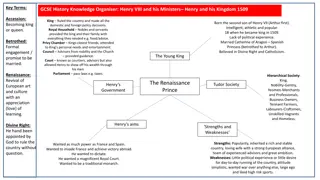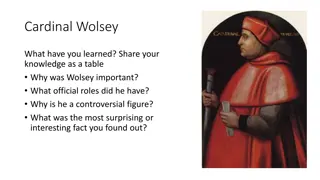The Tudor Dynasty (1485-1603): Key Events and Figures
The Tudor Dynasty (1485-1603) marked significant events in English history, including the rise of the powerful English naval fleet, acquisition of colonies, birth of the mercantile bourgeoisie, break with the Catholic Church, and spread of the Reformation spirit. Economic changes saw the transition to enclosures and development of the textile industry. Monarchs like Henry VII and Henry VIII played key roles, with Henry VIII's reign notably marked by the English Reformation and his multiple marriages.
Uploaded on Sep 30, 2024 | 0 Views
Download Presentation

Please find below an Image/Link to download the presentation.
The content on the website is provided AS IS for your information and personal use only. It may not be sold, licensed, or shared on other websites without obtaining consent from the author.If you encounter any issues during the download, it is possible that the publisher has removed the file from their server.
You are allowed to download the files provided on this website for personal or commercial use, subject to the condition that they are used lawfully. All files are the property of their respective owners.
The content on the website is provided AS IS for your information and personal use only. It may not be sold, licensed, or shared on other websites without obtaining consent from the author.
E N D
Presentation Transcript
The Tudor Dynasty (1485-1603) The most important events The English naval fleet became the most powerful in Europe; England acquired its first colonies; The birth of a modern mercantile bourgeoise; The break with the Catholic Church; The spread of the Reformation spirit
Economic changes The transition from open fields, typical of the medieval economy, to enclosures which were fields that had single owners the enclosures were concentrated in the hands of the bourgeoisie and aristocracy. The gradual development of the textile industry; A new colonial economy
Henry VII (1485-1509) The first Tudor monarch On one hand he weakened the old military nobility (knights, barons...) by confiscating much of its wealth, on the other hand he promoted the emergence of the new middle class, that is the bourgeoisie (merchants) The wealthy bourgeoisie supported economically the the king; He was able to concentrate more and more power in his hands; He made great investment in ship-building ( worldwide explorations) new lands = trade routes
Henry VIII (1509 -1547) and the English Reformation Henry VII died in 1509 and his son Henry VIII succeded him to the throne. His reign was marked by the Protestant Reformation in England. This event occured when Henry decided to divorce his wife Catherine of Aragon for both political (the growing conflict with Spain and the will to ally with France) and dynastic reasons (Catherine had given Henry a daughter, Mary, but failed to give him a male heir). When Henry asked the Pope to annull his marriage, the Pope refused. Thus, the king broke with Rome and divorced with Catherine and with the Act of Supremacy (1534) he made him the Supreme Head of the Church in England. Thanks to ths act the Church of England was separated from the Catholic one and the King was Head of the Anglican Church.
Henry VIII and his wives In 1533 Henry VIII married Anne Boleyn, who gave birth to a girl, Elisabeth. In 1536 she was executed on charges of having extramarital affairs with different men; The king married Jane Seymour, who gave him a son, Edward. She died of childbirth. Henry had three more wives: Anne of Cleves, Catherine Howard and Catherine Parr who played an important role in the upbringing of Prince Edward and Princess Elisabeth, both of whom became monachs.























